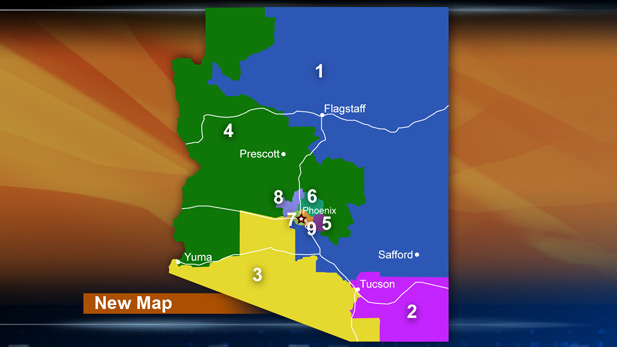 Arizona congressional districts, approved in 2012.
Arizona congressional districts, approved in 2012.
Listen:
The U.S. Supreme Court will hear arguments Monday over whether Arizona legislators or the voter-approved Independent Redistricting Commission should draw congressional district boundaries.
Republican legislative leaders filed the challenge, saying the lawmakers' authority to govern state elections under the U.S. Constitution was usurped by the system voters created in passing a state constitutional amendment in 2000.
Voters approved the change, taking the authority for drawing congressional and state legislative boundaries from the Legislature and giving it to the Independent Redistricting Commission.
The commission did so in 2001 and again in 2011. Legislators did not challenge the boundaries drawn in 2001, but they did the second time around, after the redistricting led to five Democrats and four Republicans being elected to Congress from the state in 2012. Last fall, that was reversed, with five Republicans and four Democrats elected.
The Republican legislators argue that the current system violates the election clause of the U.S. Constitution. That clause gives the power of determining the time, location and manner of election for members of the House and Senate to the Legislature.
“Whether we want our elected representatives to draw those lines in those districts or should it be done by the unelected commission,” said Tim Sifert, spokesman for the Arizona Republican Party.
Sifert said it is the GOP’s preference to have, “more voter involvement, more accountability and having elected members of the Legislature draw those district lines.”
The Legislature is involved with the redistricting commission. The House speaker, Senate president and the two minority leaders appoint two Republican and two Democratic commission members. Those four members then elect a fifth member, a political independent, to serve as chair.
“The power of redistricting really should not be in the hands of those who stand to benefit the most,” said D.J. Quinlan, executive director of the Arizona Democratic Party. “In other words the voters should pick their politicians, not the other way around."
Arizona is not the only state that uses a commission to redraw political boundaries every decade, and that means the Supreme Court's decision may have a wide effect.
One legal scholar said he finds the case interesting because it involves a question not often brought to the nation’s highest court.
“The Supreme Court had a couple of cases back almost 100 years ago where it said that, for example, Ohio voters could use a ballot initiative to repeal a redistricting plan and that was perfectly fine,” said Michael Li, counsel for the Democracy Program at the Brennan Center for Justice at New York University School of Law.
Li said most people have considered the issue settled, and he was surprise when the court took the case.
If the court sides with the Legislature and finds the districts were unconstitutionally drawn, the maps will have to be changed before the 2106 election cycle.
Who would draw the new maps is a topic of debate, Li said.
“I suspect that there would be claims saying the courts would need to draw new maps, on the other hand I would expect the Legislature to say well we are going to draw the new maps,” he said.
The political parties and candidates are paying particular attention to the case because, until the matter is resolved, candidates do not know what districts they will run in.
“People have to figure out what does the electorate look like in the old district, how does that change if there is a potential new district,” Sifert said.
There is also the possibility of more court action if the Legislature wins the case, Quinlan said.
“As a party, we are going to have to continue to advocate and look for legal solutions if the court goes the other way,” he said.
Candidates must file for office in late May 2016.
After the commission's first redistricting in 2001, lawyers representing Latino voters sued, and it took nearly eight years to reach final resolution.

By submitting your comments, you hereby give AZPM the right to post your comments and potentially use them in any other form of media operated by this institution.